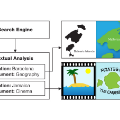Multimodal machine learning is an emerging area of research, which has received a great deal of scholarly attention in recent years. Up to now, there are few studies on multimodal conversational emotion recognition. Since Graph Neural Networks (GNNs) possess the powerful capacity of relational modeling, they have an inherent advantage in the field of multimodal learning. GNNs leverage the graph constructed from multimodal data to perform intra- and inter-modal information interaction, which effectively facilitates the integration and complementation of multimodal data. In this work, we propose a novel Graph network based Multimodal Fusion Technique (GraphMFT) for emotion recognition in conversation. Multimodal data can be modeled as a graph, where each data object is regarded as a node, and both intra- and inter-modal dependencies existing between data objects can be regarded as edges. GraphMFT utilizes multiple improved graph attention networks to capture intra-modal contextual information and inter-modal complementary information. In addition, the proposed GraphMFT attempts to address the challenges of existing graph-based multimodal Emotion Recognition in Conversation (ERC) models such as MMGCN. Empirical results on two public multimodal datasets reveal that our model outperforms the State-Of-The-Art (SOTA) approaches with the accuracy of 67.90% and 61.30%.
翻译:多模态机器学习是一个新兴的研究领域,在近年来得到了学术界极大的关注。迄今为止,关于多模态会话中情感识别的研究尚少。由于图神经网络( GNNs )具有关系建模的强大能力,在多模态学习领域具有固有的优势。GNNs 利用从多模态数据构建的图来执行节点内部和节点间信息交互,有效促进了多模态数据的集成和补充。 本文提出了一种新颖的基于图网络的多模态融合技术(GraphMFT),用于会话中的情感识别。多模态数据可以被建模为一个图,其中每个数据对象被认为是一个节点,并且存在于数据对象之间的节点内部和节点间的依赖关系可以被视为边缘。GraphMFT 利用多个改进的图注意力网络来捕获节点内部的上下文信息和节点间的互补信息。此外,所提出的 GraphMFT 试图解决现有基于图的多模态会话情感识别 (ERC) 模型(例如 MMGCN)存在的挑战。在两个公共多模态数据集上的实验证明了我们的模型优于 State-Of-The-Art (SOTA) 方法,精度分别达到了 67.90% 和 61.30%。



